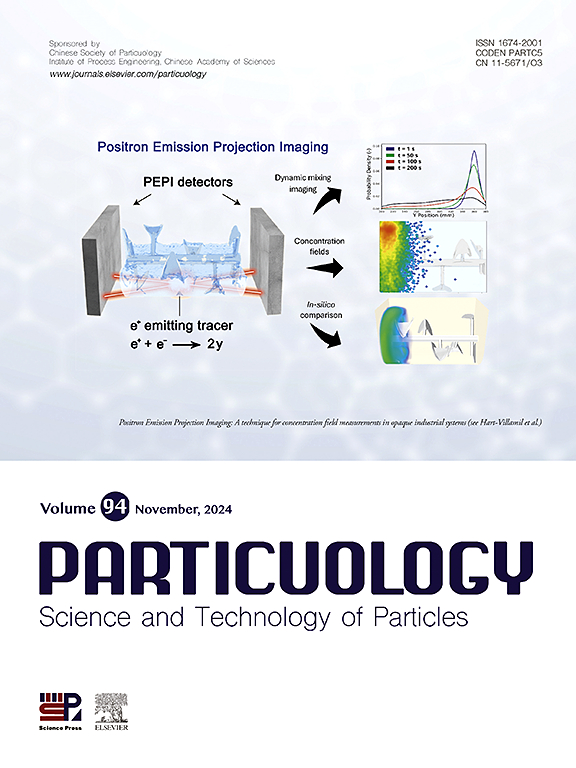关于快速流化床动力学的标度规律:关键评论和最终解决方案
IF 4.1
2区 材料科学
Q2 ENGINEERING, CHEMICAL
引用次数: 0
摘要
阿基米德数(Ar)是表征流-颗粒两相流系统最重要的参数,它决定了单个颗粒的终端速度与最小流化气速的比值,进而决定了两种流化系统在快流化流型中相似的可能性。在简要回顾了文献中报道的标度规律后,发现了Ar缺失的问题/局限性。从Glicksman的全套标度律出发,导出了新的简化的中尺度相似度四恒等标度律。由作者和他的同事建立的快速流化动力学统一模型也证实了这一点。当将新标准应用于高温循环流化床燃烧室缩小到冷空气模型时,发现并宣布了床尺寸的约十分之一半自发缩放。有了这个优势,从直径15米的大型CFB燃烧室缩小到1/20冷模型成功地进行了演示。为了获得局部/宏观尺度的相似性,还对使用相同气体和颗粒的床层进行了进一步的简化。在统一模型的指导下,得到了具有两个相似恒等式的最简单标度律。这与Qi和Zhu从几十个文献数据集和他们自己的数据集中推断出的经验相关性非常吻合。本文章由计算机程序翻译,如有差异,请以英文原文为准。

On scaling laws of fast-fluidized-bed dynamics: Critical remarks and final solution
Archimedes number (Ar) is the most important parameter characterizing the fluid-particle two-phase-flow system, which determines the ratio of terminal velocity of single particle to minimum gas velocity for fluidization, and then the possibility of two fluidized systems being similar in fast-fluidization flow-regime. After brief revisit of the scaling laws reported in literatures, the problem/limitations of missing Ar were revealed/identified. Starting from Glicksman's full set scaling laws, new simplified four identities scaling laws for mesoscale similarity were derived. They were confirmed, also, by the unified model for fast fluidization dynamics established by the present author and his co-workers. When the new criteria were applied for scaling-down a high-temperature CFB combustor to a cold-air model, about one tenth semi-spontaneous scaling for bed size was identified and declared. With this benefit, scaling down from a large CFB combustor, of 15 m in diameter, to a 1/20 cold model was demonstrated successfully. Further simplification was also conducted to the beds using same gas and particles for partial/macroscale similarity. With guidance of the unified model, the simplest scaling laws having two similitude identities were obtained. And this is coincident well with Qi and Zhu's empirical correlation, deduced from dozens more literature data sets and their own.
求助全文
通过发布文献求助,成功后即可免费获取论文全文。
去求助
来源期刊

Particuology
工程技术-材料科学:综合
CiteScore
6.70
自引率
2.90%
发文量
1730
审稿时长
32 days
期刊介绍:
The word ‘particuology’ was coined to parallel the discipline for the science and technology of particles.
Particuology is an interdisciplinary journal that publishes frontier research articles and critical reviews on the discovery, formulation and engineering of particulate materials, processes and systems. It especially welcomes contributions utilising advanced theoretical, modelling and measurement methods to enable the discovery and creation of new particulate materials, and the manufacturing of functional particulate-based products, such as sensors.
Papers are handled by Thematic Editors who oversee contributions from specific subject fields. These fields are classified into: Particle Synthesis and Modification; Particle Characterization and Measurement; Granular Systems and Bulk Solids Technology; Fluidization and Particle-Fluid Systems; Aerosols; and Applications of Particle Technology.
Key topics concerning the creation and processing of particulates include:
-Modelling and simulation of particle formation, collective behaviour of particles and systems for particle production over a broad spectrum of length scales
-Mining of experimental data for particle synthesis and surface properties to facilitate the creation of new materials and processes
-Particle design and preparation including controlled response and sensing functionalities in formation, delivery systems and biological systems, etc.
-Experimental and computational methods for visualization and analysis of particulate system.
These topics are broadly relevant to the production of materials, pharmaceuticals and food, and to the conversion of energy resources to fuels and protection of the environment.
 求助内容:
求助内容: 应助结果提醒方式:
应助结果提醒方式:


